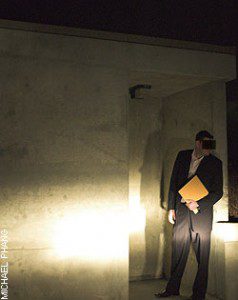Paper Thin
The law offers little protection for journalists who want to keep sources confidential. But there are some things you can do—and should know
On April 5, 2001, a brown paper envelope arrived anonymously at the Ottawa offices of the National Post. It was addressed to Andrew McIntosh, an investigative reporter who had been looking into then-Prime Minister Jean Chrétien’s business dealings in his Quebec riding, which was known at the time as Saint-Maurice. McIntosh was particularly interested in the prime minister’s involvement in the sale of the Grand-Mère Inn, and the mysterious document seemed to support his suspicions. It was a copy of what purported to be a $615,000 loan authorization from the Business Development Bank of Canada that showed the inn owed $23,040 to JAC Consultants, a Chrétien family holding company. McIntosh realized that if these documents were real and not forged, as Chrétien, his lawyers and the BDC later claimed, they could place the prime minister in a conflict of interest and trigger demands for a wider investigation.
The next week, McIntosh was notified by a source – one to whom he had already pledged confidentiality while obtaining other information – that the document had come from him or her. The source asked McIntosh to destroy the document so that his or her identity would not be revealed through fingerprinting or DNA analysis. McIntosh refused and moved the document to a safe place. On July 4, 2002, the Royal Canadian Mounted Police obtained an unprecedented search warrant and assistance order that would help them obtain the document. Believing its Charter rights were being violated, the Post applied for an order to quash the warrant and assistance order.
Two years later, in November 2004, Ken Peters, a reporter with The Hamilton Spectator, found himself in court. “I’m sorry, your honour. With all due respect, I can’t do that,” he said in a loud, unwavering voice when Ontario Supreme Court Judge David Crane ordered him to divulge the name of a third person who was in the room when he was handed documents alleging abuse and neglect in a Hamilton nursing home. Peters, who knew that revealing the name of the other person in the room would ultimately lead to the disclosure of his source, refused. Crane cited him with contempt of court, and Peters was left to wait for his next court date to find out his penalty.
 Although both cases involved secret documents and confidential sources, the outcomes – both of which are being appealed – were starkly different. McIntosh and the Post were ultimately able to keep their source from being revealed, while Peters was found guilty of contempt. Crane ordered the Spectator to pay a fine of $31,600 – the largest penalty ever levied in a contempt case against a newspaper in Canada.
Although both cases involved secret documents and confidential sources, the outcomes – both of which are being appealed – were starkly different. McIntosh and the Post were ultimately able to keep their source from being revealed, while Peters was found guilty of contempt. Crane ordered the Spectator to pay a fine of $31,600 – the largest penalty ever levied in a contempt case against a newspaper in Canada.
In McIntosh’s case, Justice Mary Lou Benotto chose to quash the warrant and assistance order against McIntosh and the Post specifically because they violated section 2(b) of the Canadian Charter of Rights and Freedoms by eroding the ability of the press to inform the public. She also found that protecting the confidential source was vital to the public’s interest, and that the fingerprint analysis of documents would do little to advance the case.
In Peters’s case, Justice Crane moved the proceedings from criminal to civil court, likely to keep Peters from having a criminal record. But Crane chose to proceed with the $31,600 fine even though the identity of Peters’s confidential source, former city councillor Henry Merling, was ultimately revealed in court by another city councillor. In his ruling, Crane attacked the business of journalism, describing newsroom culture as “oppressive” because it forced reporters to make promises they could not keep. He also referred to Peters as a “pawn in a much larger game” – something Peters and Spectator editor-in-chief Dana Robbins believe demonstrated an appalling lack of knowledge of how newsrooms actually work.
To some people, especially those unacquainted with the nuances of law, the conflicting outcomes in these cases could be construed as perplexing. One judge recognized the importance of journalist? source confidentiality, while the other chastised journalists for making promises of confidentiality they could not keep. But it’s important to realize the details of the cases are not the same. Dean Jobb, an assistant professor of journalism who teaches media law at the University of King’s College in Halifax says the search for the confidential source in McIntosh’s case was a fishing expedition because searching for fingerprints on the document would likely have proven unsuccessful. On the other hand, he says, revealing the source in the Peters case was key to advancing a $15-million trial suit against the City of Hamilton. Although the courts usually bend over backwards to avoid rulings similar to Peters’s, Jobb says information in this case was crucial to the trial and there wasn’t much else the judge could do. “What journalists should take from that is,” says Jobb, “if it’s not crucial to the case, if it isn’t relevant, you’re not going to have to give it up.”
So what can reporters conclude? Despite the differences in the cases, the opposing and quite passionate statements made by the judges suggest that there are no precise rules in law surrounding the protection of sources – and there probably never will be. “Everyone hailed the McIntosh decision as a precedent for protection of sources,” says Mark Bantey, a Montreal media lawyer with Gowling, Lafleur and Henderson. “But if you read it carefully, the judge says very explicitly that every case has to be decided on a case-by-case basis, and the public’s right to know has to be balanced with other considerations before you grant privilege to a reporter. In fact, I don’t think it is a huge precedent. It merely reiterates the rules that already exist.”
Historically, English common law cited only relationships between lawyers and their clients, police and informers, and spouses as privileged. A privileged relationship means that communication is exempt from the powers of a court to demand it be heard. In current Canadian law, communication between doctors and patients, priests and confessors, and journalists and sources isn’t privileged, and whether a court will force them to reveal evidence is decided on a case-by-case basis, with much of the outcome resting on the socalled Wigmore criteria.
In 1905, John Henry Wigmore, dean of law at Northwestern University in Chicago, concluded that if the following four stipulations are met, the judge may rule that the communication is privileged: one, the communication originated in confidence; two, confidentiality is essential to the maintenance of the relationship between the parties; three, the community sees the relationship as important; and four, disclosure of the communication would do more harm than good.
The Charter, which came into force in 1982, combined with the Wigmore criteria, has improved how source confidentiality is dealt with in court. That’s because section 2(b) of the Charter gives Canadians the right to freedom of thought, belief, opinion and expression, including freedom of the press. These rights are upheld in most cases, except where they can be justifiably limited. So, only when the court determines that the importance of a trial trumps the importance of keeping a source confidential must a journalist either give up the source or face a fine and possibly a prison sentence. No Canadian journalist has ever gone to jail for protecting a source, but in the Peters case, the Spectator was levied a stiff penalty.
A recent ruling dealing with confidential sources shows how the Wigmore criteria and the Charter work together. During the pre-trial discovery phase on October 18, 2005, Alberta Court of Queen’s Bench Justice Vital Ouelette denied an application by former Edmonton police chief Bob Wasylyshen to force CBC to turn over 627 pages of confidential documents. Justice Ouelette was hearing a defamation suit over a segment of a Disclosure television program alleging that Wasylyshen had engaged in sexual relations and unlawful conduct with prostitutes. Ouelette used the Charter and the Wigmore criteria to decide that in this instance, “The interests served by protecting the communication outweigh its immediate disclosure.” While this seems like a victory for Canadian journalism, the trial judge may still order the documents to be released once the actual trial begins.
For many journalists, a case-by-case analysis under the Wigmore criteria and the Charter isn’t good enough. “There should be a more absolute rule protecting sources,” says Bantey, “because in the long run, it would be beneficial to the public to give reporters some sort of privilege. The public would end up getting more information.” The most obvious option is for Canada to adopt a press shield law, similar to ones used in thirty-one American states and the District of Columbia. While these laws are supposed to protect confidential sources and information from being revealed in court, they’re no panacea. Some provide absolute privilege, but others are subject to a judge’s discretion. Also, there is no federal shield law in the U.S., which means that journalists are protected only in state courts and not in federal courts. So, while having shield laws in Canada could create more consistency in the courts, they would probably not be absolute, which would still make a judge’s discretion the ultimate deciding factor.
Spectator editor-in-chief Robbins would like to see a clearer approach taken on the question of protecting sources. He says in the absence of a shield law, the federal government could spell out a specific process that the courts must follow when subpoenaing reporters – similar to the route already taken with publication bans, which includes notifying the media and allowing their lawyers to object to a ban. Although it’s not a perfect solution, Robbins says creating a similar process for subpoenaing reporters would help establish consistency and transparency.
Any way you look at it, journalists are at risk when they promise confidentiality to a source. For instance, last year, New York Times reporter Judith Miller was sentenced to eighteen months in jail after she refused to divulge the identity of a source – I. Lewis “Scooter” Libby, U.S. Vice-President Dick Cheney’s chief of staff and assistant to the vice-president for national security affairs – who leaked the name of a CIA operative. Miller decided to talk after serving eightyfive days of her sentence, even though she was given leave by her source right from the beginning. Even so, there have been numerous instances where it has been beneficial for journalists to use confidential sources. The most famous case is the Watergate scandal, of course.Washington Post reporters Bob Woodward and Carl Bernstein wrote articles from 1972 to 1976 based on information they received from an off-the-record source nicknamed Deep Throat (who we learned just last year was W. Mark Felt, the FBI’s second-highest ranking official). Under deep cover, Felt confirmed facts and added context to the duo’s investigation, which eventually led to the impeachment and resignation of President Richard M. Nixon in 1974.
Like Deep Throat, many other confidential sources have been paramount in revealing societal wrongdoings. Few would dispute the importance of keeping their identities hidden. The exposure of Canada’s 1985 tainted tuna scandal – when Fisheries Minister John Fraser approved the sale of one million cans of rancid StarKist tuna – relied on confidential sources. So did the “Dirty Dining” series published by The Toronto Star in 2000, which improved health standards in Toronto restaurants. But when journalists are forced to reveal their sources in court, it puts a chilling effect on the future of investigative journalism. “If sources don’t feel comfortable to come forward to expose some kind of wrongdoing,” said Anne Kothawala, president of the Canadian Newspaper Association, in a statement to media organizations the day after Peters was cited for contempt, “then those stories that serve the public interest – where we find out about wrongdoing or corruption or any of those types of issues – aren’t going to come out because people are not going to feel protected in coming forward to a journalist.”
Without the unequivocal protection of the law, journalists have to take measures to protect themselves. Before proceeding, the first thing reporters should do is make the terms of the agreement absolutely clear. Jennifer Fowler, national vice-president of the Canadian Association of Journalists, suggests asking sources a number of questions: Can I tell my colleague that I talked to you? Can I tell my editor that I talked to you? Can I use the information that you’re giving me in my story? Can I use the information you’re giving me when I talk to other people?
Since there are no formal definitions for terms like “off the record,” “not for attribution” and “on background,” it’s important to clarify. The CAJ defines them on their website. Not for attribution: “We may quote statements directly, but the source may not be named, although a general description of his or her position may be given (‘a government official,’ or ‘a party insider’). In TV and radio, the identity may be shielded by changing the voice or appearance.” On background: “We may use the thrust of statements and generally describe the source, but we may not use direct quotes.” Off the record: “We may not report the information, which can be used solely to help our own understanding or perspective. There is not much point in knowing something if it can’t be reported, so this undertaking should be used sparingly, if at all.”
Journalists should also make sure their news organizations are willing to pay the court costs. Warren Barton, a retired editor who worked for The Globe and Mail and the Spectator, advises freelancers to never go off the record because if the story leads to a court action, they’re on their own without a lawyer from a powerful organization to help them. Even when journalists are represented by media lawyers, it’s important to take precautions. Journalists must keep their notes on hand in case of a defamation case, but they should make sure that nothing in their notes would give up a source. Bert Bruser, the Star‘s libel lawyer, doesn’t understand why journalists include the name of confidential sources in their notes in the first place, or why they keep secret documents around that would reveal the source. “If the police come with a search warrant to get your notes,” he says, “and your notes contain the name of the confidential source, then you’ve got a problem because you made a promise that you can’t keep.”
Before journalists and editors at the Star use a confidential source, they make sure they know why the source doesn’t want to be identified, if the source is in a position to know the facts and if the source has vested interests or biases. “It’s not to say you don’t use information because someone might have an axe to grind,” says Robert Cribb, a Star investigative reporter. “People with axes to grind still have extremely valuable information that the public would want to know, but it’s very important to understand what the biases are so you know how to treat the information.” Cribb’s experience using confidential sources has taught him that there’s a possibility confidential sources may lie, so he says the same thing to every source: “If you lie to me – and I’ll probably find out because I’ll be talking to a lot of people – the deal is off.” It’s his only caveat to the deal.
But journalists shouldn’t just take precautions that prevent them from being duped or that decrease the chance they’ll have to testify in court. They should also try to maintain credibility for their news organization. In their book, The Elements of Journalism, Bill Kovach and Tom Rosenstiel stress the importance of transparency. That means if you’re not going to name a source, you should tell your reader why. “It certainly should be as explicit as possible who the source is,” says Jobb. “Not by name, but by what makes them credible.”
While the McIntosh ruling seemed like a great victory for the future of Canadian journalism, and the Peters ruling seemed like a grand defeat, neither case will have an overwhelming effect on how confidential sources are treated in court. They will continue to be ruled on a case-by-case basis. Confidential sources need to be protected, but since Canadian law won’t be changing anytime soon, reporters need to be honest with them. Jobb says, “Journalists should just level with their source and say, ‘I will do everything I can, but you have to recognize that if this ever went to court, and if I ever were compelled to give this information, I have no legal right to deny that.’ And I’ve done that with sources, and you know what they say? ‘Thanks. Sure.’ And they’ll tell me.” Sometimes the simplest solutions are the best ones.
by Carly Baxter
Carly Baxter was the Head of Reseach/Circulation for the Spring 2006 issue of the Ryerson Review of Journalism.












































